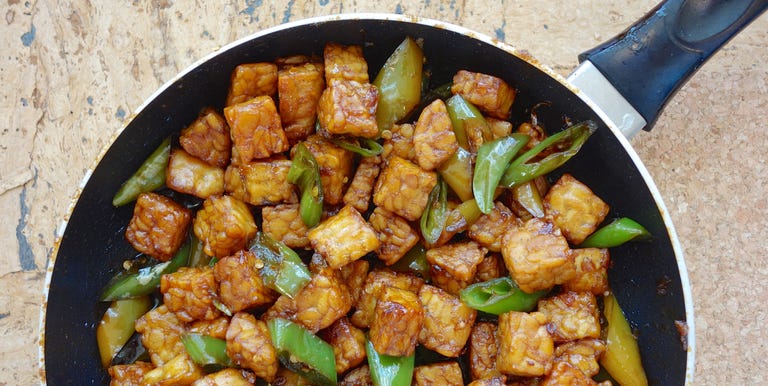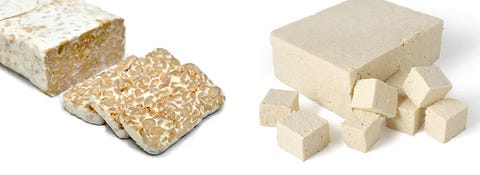

“Fake meat” sounds, well, pretty disgusting. But many vegans will swear on a pile of vegetables that tempeh and other faux meat products actually taste just like the real thing.
Mmm-hmm, ?.
Jury’s out on that, but tempeh can actually be pretty tasty. Still, if you’re not even sure what the difference is between tempeh vs tofu, here’s a rundown on the meat alternative taking the ‘grammable Buddha bowl world by storm.
What is tempeh?
Tempeh is a meat alternative made from cooked and fermented soy beans, according to Amy Shapiro, R.D. and founder of Real Nutrition NYC. The cooked beans are pressed and shaped into a brick. People use it to mimic bacon, chorizo, and other meat products.
A post shared by Elisa ????Plant Based Foodie ? (@happyskinkitchen) on
A post shared by BBQ REVOLUTION (@bbqrevolution) on
A post shared by Sabina (@sa.binka) on
While soy is its main ingredient, tempeh often contains ingredients like brown rice, quinoa, millet, flax seeds, and sesame seeds, says Margie Saidel, R.D. and vice president of culinary, nutrition, and sustainability at Chartwells K-12.
Tempeh nutrition and benefits
Shapiro says tempeh is a great plant-based form of protein.
Here’s the nutritional breakdown of one serving of cooked tempeh:
Shapiro says tempeh also contains about 10 percent of your daily calcium and iron needs. And since it’s fermented, it balances the healthy bacteria in your gut, which can strengthen the immune system, keep you regular, and do wonders for your skin.
Another added perk: “Reducing animal meat production also benefits the environment,” Saidel adds—which is true of tempeh and other vegetarian protein sources.
Tempeh vs tofu

People often use the terms tempeh and tofu interchangeably, but they couldn’t be any more different. “Tofu is made by curdling soy milk, where tempeh is made straight from the soybean,” says Shapiro. You can get tofu in a variety of densities like silky and soft or firm and spongy, whereas tempeh is often more firm.
Tofu is often sold or served in block rectangular form or diced cubes, with a neutral flavor and a smooth consistency. (And let’s face it…it can be kind of squishy and sad.) Tempeh is more earthy and sweet in flavor, says Shapiro, and is usually a bit coarser and chewier, better mimicking the texture of cooked meat.
Nutritionally, they’re a little different, too. Tempeh is higher in calories than tofu (195 cal compared to tofu’s 76 calories), but has more protein per serving (20 grams compared to tofu’s 8 grams).
What ingredients should you look for on the label?
As a rule of thumb, Saidel says to look for plain tempeh with as few ingredients as possible. Flavored tempeh often contains extra soy sauce and sugar—stick to fresh spices, herbs, and homemade low-salt marinades so you know what you’re actually putting into your body. If you’re gluten-free, double check that each ingredient listed is compatible with your diet.

Once you’ve already opened it, wrap it tightly and store it in the fridge for no more than five days. “When in doubt, throw it out,” Saidel says. But unopened tempeh can last up to several months in the fridge and up to three months in the freezer. To defrost it, pop it in the refrigerator overnight (like you would defrost frozen meat).
How do you cook tempeh?
Tempeh can be intimidating to the unfamiliar. Here’s what Saidel likes to do with it:
Does tempeh have any downsides?
Tempeh is made of soy beans, so if you have a soy allergy, steer clear, says Shapiro. While she also recommends that women who have breast cancer (or are breast cancer survivors) should avoid it because of soy’s estrogen-mimicking habits, the American Cancer Society says that consuming moderate amounts of soy foods is safe for everyone, including breast cancer survivors.
Source: Read Full Article